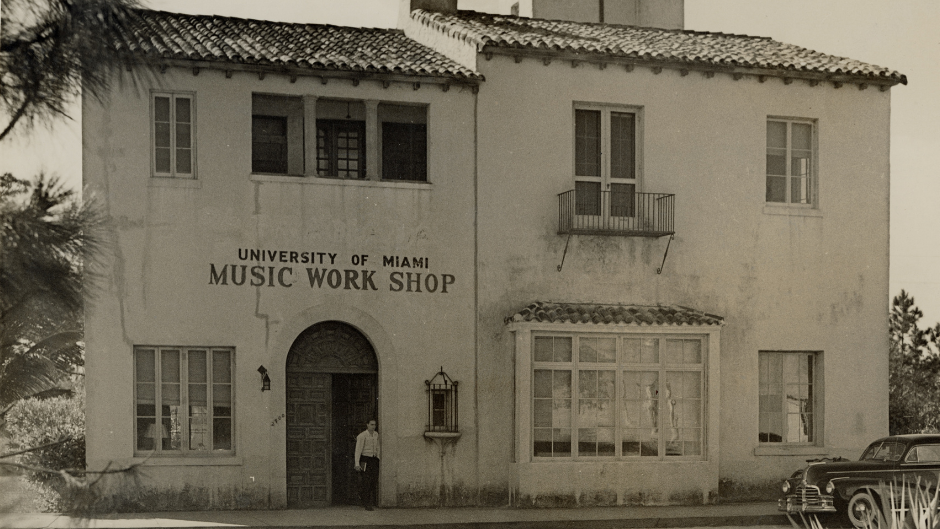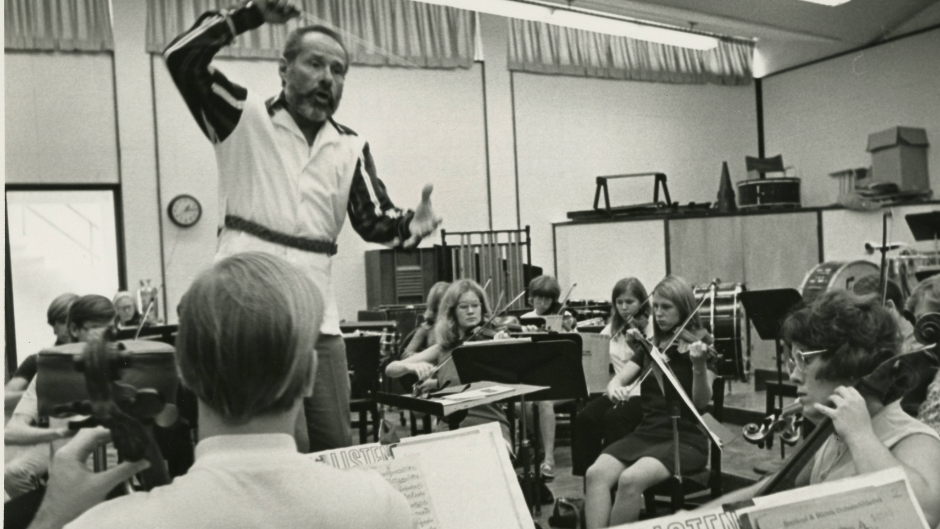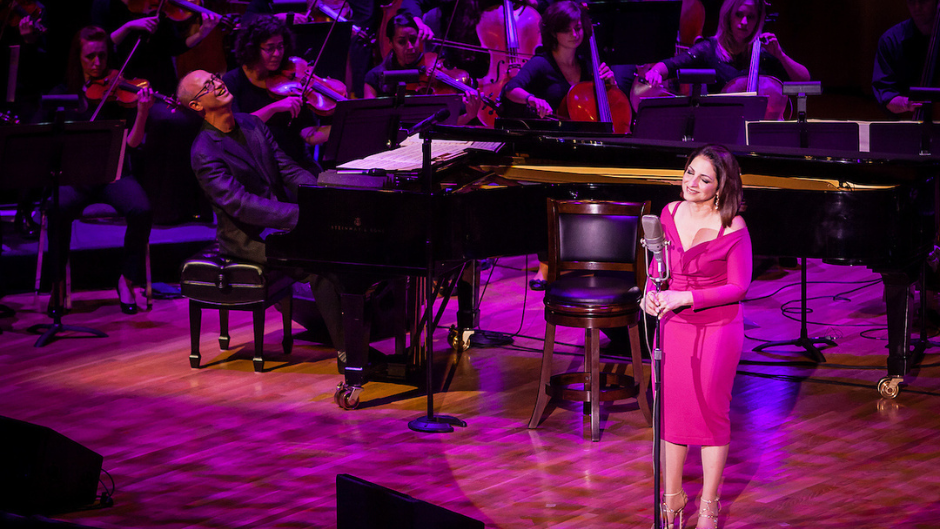The Frost School of Music has been characterized by a dynamic, can-do spirit since its beginnings a century ago, when it was launched together with the University of Miami.
The University was chartered in April 1925 with just three academic divisions: the College of Arts and Sciences, an Evening Division, and a School of Music. The City of Coral Gables was incorporated the same month, part of a building and population boom that established modern Miami-Dade. That the striving city’s first university included a music school speaks to the importance that its ambitious leaders gave to culture.
The music school was headed by Bertha Foster, a dynamo who owned a thriving private conservatory and organized 1000 schoolchildren to sing at the University’s groundbreaking. One of Foster’s first students, Christine Asdurian, an Armenian orphan adopted in America, composed the school song “Alma Mater, Stand Forever,” for what was supposed to be the University’s first football game as it started classes in September of 1926. The opening was derailed when the Great Hurricane of 1926 devastated the city. Undaunted, the University and the music school – with 25 students - opened a few weeks later.
What is now the Frost School of Music has been standing strong ever since.
The early music school was a cultural pillar of the young city. Its symphony orchestra, launched in 1927, was Miami’s leading classical music ensemble through the 1950s. Members of what is now the Frost Band of the Hour, founded in 1933, became the first bandleaders and music educators in Miami high schools.

But the music school truly began to come into its own as a groundbreaker in music education under the transformative leadership of William F. Lee, who became Dean in 1964. Lee set the music school on the trailblazing path that has defined it ever since. He launched the country’s first music business and music engineering programs. He started one of the country’s first university jazz programs, headed by Jerry Coker, one of three men who created the academic study of jazz. Lee hired pioneering faculty like Fred Fennell, a famous Boston Symphony conductor and inventor of the wind ensemble, to remake the orchestra; legendary audio engineer Bill Porter, who worked with the likes of Elvis Presley, Louis Armstrong, and Barbra Streisand, to create the engineering program; and Jim Progris, who started what is now the Media Scoring and Production program, another first. In 1980 Lee welcomed former student Larry Lapin’s proposal to start the country’s first jazz vocal program, fostering luminary artists like Jon Secada, one of the alumni artists in next Tuesday’s Centennial Celebration Concert.
Four new buildings were added under Lee, notably Maurice Gusman Concert Hall in 1975. Designed by Morris Lapidus, the definitive Miami Modern architect who designed Miami Beach's Fontainebleau and Eden Roc hotels, Gusman was a state-of-the-art venue that was the first in Miami designed for musical performances.
Lee’s adventurous spirit and pioneering programs made both the music school and the jazz program nationally famous, attracting future stars like Jaco Pastorius, Carmen Lundy, Phyllis Hyman, Pat Metheny (whom Lee recruited at a Kansas City jazz club, offering him a full scholarship on the spot) and Bruce Hornsby, both of whom will also perform at the Centennial Celebration.
Lee was succeeded in 1983 by Dean William Hipp, who organized the school’s departmental and administrative structure to sustain its rapid expansion. Festival Miami, now known as the Frost Music Live Signature Series, launched in 1984, showcasing faculty, students, and major guest artists. It was joined by a summer opera program in Salzburg, Austria, the same year. Fundraising soared. In 2003 Dr. Phillip and Patricia Frost donated $33 million, the largest gift ever made to a university-based music school, which was renamed in their honor. Naming gifts from L. Austin and Marta Weeks propelled the construction of two key buildings: the L. Austin Weeks Center for Recording and Performance, with a recital hall and state-of-the-art recording studio; and the Marta and Austin Weeks Music Library and Technology Center (which will celebrate its 20th anniversary on April 10.)

A new era began under Shelton G. “Shelly” Berg, an internationally recognized musical artist and educator who became dean in 2007. Berg has led a transformation to meet radical changes in the 21st-century music world. At its heart is the Experiential Music Curriculum, developed through two years of work with faculty. Now known as the Frost Method, it is a cross-disciplinary approach that fosters not just musical talent, but the broad range of creative and professional skills – from composing, improvisation, and arranging to technology, entrepreneurship, and audience engagement – that students need to succeed. It’s a dramatically innovative and comprehensive ethos that has enabled the Frost School to set a new standard for 21st-century music education.
“We don’t have silos; our model is “Build Yourself,” says Berg. “Most of our peers would say, ‘If you want to be a classical violinist and a music engineer, well, you have to choose–it’s this or that. At Frost, it’s this and that. We have to acknowledge that it’s not 100 years ago and that the skillset musicians need is more varied and more complex than 100 years ago.”
Berg brought the Henry Mancini Institute to the Frost School, where superbly talented graduate students perform and record with the likes of Stevie Wonder, Chick Correa, Andrea Bocelli, Quincy Jones, and Miami-bred pop star Gloria Estefan - a University alumna and recipient of a 1994 honorary doctorate from the Frost School who, with her famous husband Emilio Estefan, has become a strong supporter.
Another major addition has been the Creative American Music Program (CAM), endowed by Hornsby and his wife Kathy, for aspiring songwriters. CAM propelled the creation of the Modern Artist Development and Entrepreneurship (M.A.D.E.) major. The two programs attract aspiring songwriters and performers in a wide range ofgenres beyond jazz and classical, including pop, rock, R&B, hip-hop, country, Latin, electronica, Americana, and more. Today, those young contemporary artists make up a third of the Frost School’s undergraduate class.
They’re able to combine M.A.D.E. or CAM studies with programs such as engineering or media production – like Centennial Concert performers Alexis “Idarose” Kesselman and Carter Vail, producers and songwriters who’ve parlayed the multiple skills they learned at the Frost School into success.
Other efforts launched under Berg’s tenure include a summer jazz academy in partnership with Jazz Aspen Snowmass and a classical music program with Festival Napa Valley, as well as the Donna E. Shalala MusicReach Program, offering free, world-class music instruction and mentorship to over 1,000 underserved Miami-Dade public school students.
The Frost School reached another major goal in late 2023 with the opening of the $36.5 million Knight Center for Music Innovation, with a world-class recital hall and a space for cutting-edge technological experimentation. It is another pivotal milestone in the Frost School’s ever-evolving history of innovation.
Because even as the Frost School prepares to celebrate its first century, it is looking towards the next one.

